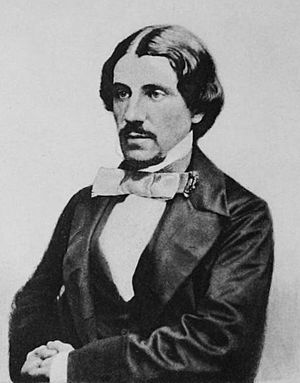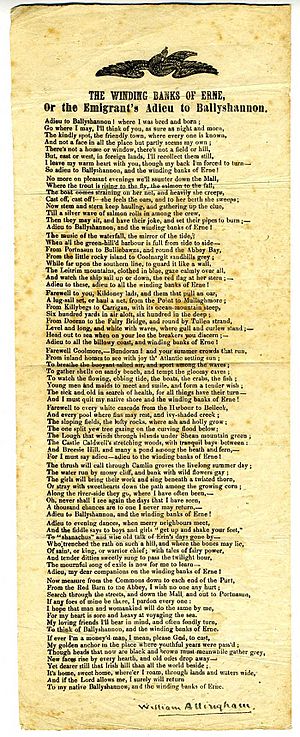William Allingham facts for kids
Quick facts for kids
William Allingham
|
|
|---|---|
 |
|
| Born | 19 March 1824 Ballyshannon, County Donegal, Ireland
|
| Died | 18 November 1889 (aged 65) Hampstead, London
|
| Nationality | Irish |
| Occupation | poet, scholar |
| Spouse(s) | |
William Allingham (born March 19, 1824, died November 18, 1889) was an Irish poet, diarist, and editor. He wrote many collections of poems. His poem "The Faeries" was very popular and appeared in many poetry books. Allingham is also famous for his Diary, which was published after he died. In this diary, he wrote about his interesting meetings with other famous writers and artists. These included Alfred Tennyson and Thomas Carlyle. His wife, Helen Allingham, was a well-known artist who painted with watercolors and drew pictures for books.
Contents
William Allingham's Life Story
William Allingham was born on March 19, 1824. He grew up in Ballyshannon, a small town in County Donegal, in the north of Ireland. His father managed a local bank. William was the oldest of his siblings. He had two younger sisters, Catherine and Jane, and two younger brothers, John and Edward. Sadly, Edward lived for only a few months.
As a child, William loved the countryside and gardens. He learned to paint and enjoyed listening to his mother play the piano. When he was nine years old, his mother passed away.
William went to school at the Royal Belfast Academical Institution. When he was 14, he started working at the customs office in his hometown. He worked in similar jobs in Ireland and England until 1870. During this time, he published his first book of Poems in 1850. This book included his famous poem, "The Fairies." He also published Day and Night Songs in 1855. This book featured drawings by famous artists like Dante Gabriel Rossetti.
In 1864, Allingham published Laurence Bloomfield in Ireland. This was a long poem about social issues in Ireland. It was his most ambitious work. He also helped put together other poetry books, like The Ballad Book in 1864 and Fifty Modern Poems in 1865.
In April 1870, Allingham stopped working for the customs service. He moved to London and became an assistant editor for Fraser's Magazine. He later became the main editor in 1874 and stayed in that job until 1879.
On August 22, 1874, William Allingham married Helen Paterson. She was an illustrator and 24 years younger than him. After they married, Helen became a famous watercolor painter. They first lived in London, close to Allingham's friend, Thomas Carlyle. Their first two children, Gerald and Eva, were born there. In 1877, Allingham published Songs, Poems and Ballads.
In 1881, after Carlyle died, the Allinghams moved to a place called Sandhills in Surrey. Their third child, Henry, was born there in 1882. During this period, William published more books of poems. These included Evil May Day (1883), Blackberries (1884), and Irish Songs and Poems (1887).
A man named John George Adair was known for forcing many families out of their homes. In 1861, he evicted 244 people from their homes in Derryveagh, County Donegal. This sad event earned him the nickname "Black Jack Adair." William Allingham was deeply affected by this. He wrote a poem called The Eviction about it.
In 1888, William Allingham's health began to get worse. So, he and his family moved back to London, to a village called Hampstead. He passed away in Hampstead on November 18, 1889. He wished to be cremated. His ashes are buried at St. Anne's church in his hometown of Ballyshannon.
After he died, some of Allingham's other writings were published. These included Varieties in Prose in 1893. His William Allingham. A Diary was published in 1907. This diary shared his memories of famous writers and artists, like Alfred Tennyson and Thomas Carlyle.
His Poems and Their Impact
William Allingham wrote many beautiful poems that described nature and feelings. His best poems truly captured the spirit of Ireland and its local places. His writing was clear, fresh, and graceful. His most famous poem is still "The Faeries," which he wrote early in his career.
Allingham had a big impact on other poets. W. B. Yeats, a very famous Irish poet, was influenced by him. Another poet from Ulster, John Hewitt, also felt Allingham's influence strongly. Hewitt even tried to make Allingham's work more well-known by editing his poems. Allingham's own collection of poems, Nightingale Valley (1862), also inspired another famous book. This was Come Hither by Walter de la Mare, published in 1923.
Allingham's Poems in Pop Culture
The Allingham Arms Hotel in Bundoran, County Donegal, is named after William Allingham.
Lines from his poem "The Faeries" have appeared in many places. For example, the character of The Tinker quoted "We daren't go a-hunting / For fear of little men […]" in the movie Willy Wonka & the Chocolate Factory. The same lines were also used in a comic book story called Hellboy: The Corpse and in the 1973 horror film Don't Look in the Basement.
Other lines from the poem, "Up the airy mountain / Down the rushy glen […]", are part of a character's thoughts in the Discworld novel Lords and Ladies. A character in a Supergirl comic book also quoted several lines from the poem in 2011. The science fiction novel Dare to Go A-Hunting by Andre Norton (1990) also quoted this poem.
"Up the Airy Mountain" is also the title of a short story by Debra Doyle and James D. Macdonald. And the first working title for Terry Pratchett's book The Wee Free Men was "For Fear of Little Men."
See also


